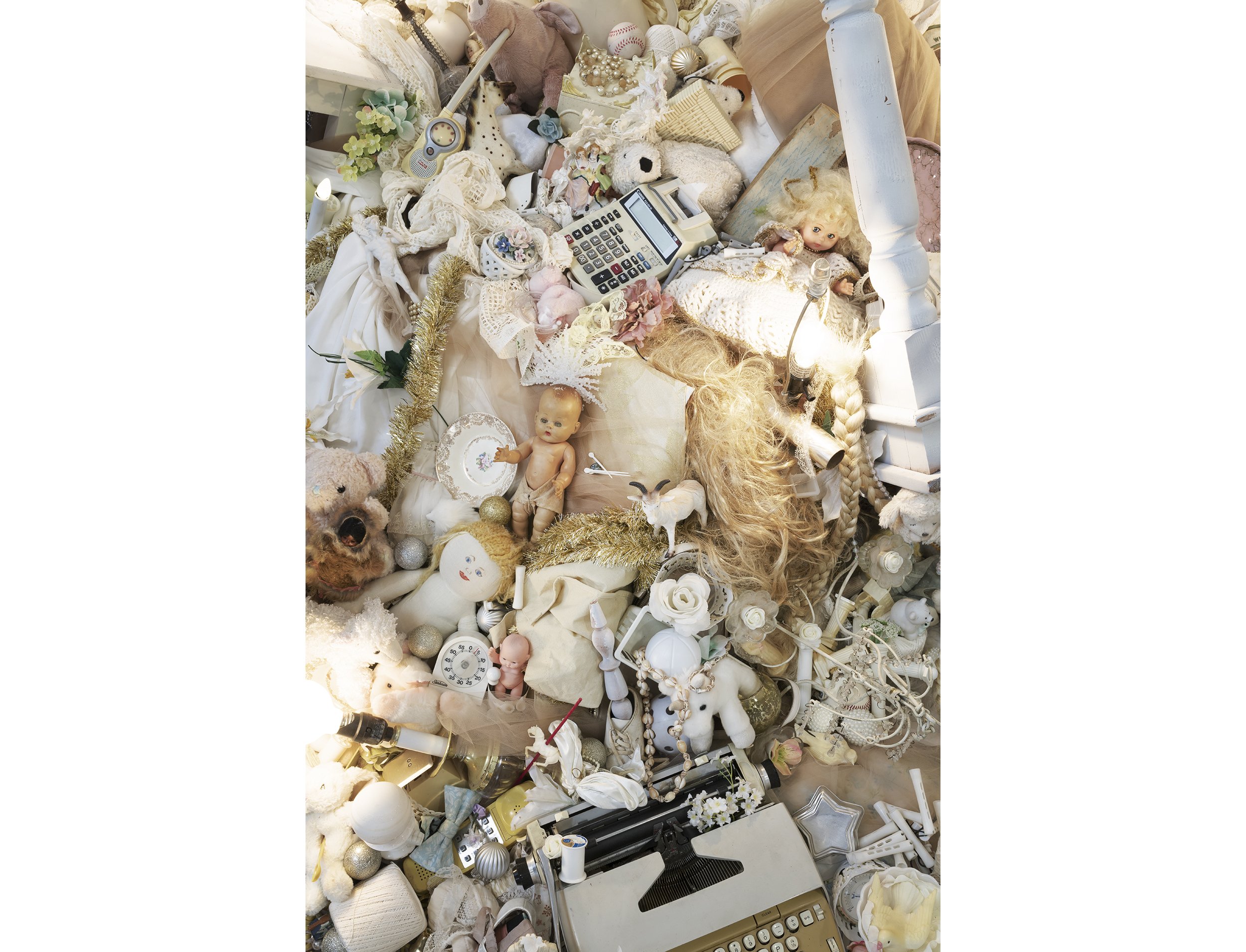Dim Gold
Installation, 2022
Dim Gold is an allegory of marital covenant, bodily death, and the hope of love’s consummation in afterlife. The throne heap consists of discarded clothing, broken appliances, old lamps, unwanted toys, bruised furniture, fake flowers, stained curtains, human and synthetic hair, scratched glasses, deflated soccer balls, faded photographs, won shoes, chipped figurines, kitchen utensils, costume jewelry, yellowed wedding decorations, cracked dishes, Christmas ornaments, mildewed books and bathtub plugs.
Dim Gold was an installation commissioned by Bridge Projects for the exhibition “Here After”.
From the exhibition catalog, written by curator Cara Megan Lewis:
“Irish Poet John O’Donohue wrote in his 1997 book Anam Cara, that upon birth you are accompanied by a “presence who walks the road of life with you… The name of this presence is death.” Our lives are spent accompanied by this invisible presence until one day, the veil is lifted and we are finally wed to that which was once a mystery. We arrive at our eternal home. “What are the trimmings of our eventual home? When will we get there and what does it look like?” are the questions queried by Mandy Cano Villalobos’ found object installations. Sock monkeys, toy race cars, and thrift store lighthouse paintings pile one on top of the other and this pile is balanced - sometimes precariously - on top of a tricycle, or a throne, or a raft. The thrust of Villalobos’ practice is an attempt to visualize human longing for our eternal place of belonging in heaven. This act of the imagination has led Villalobos to create a sacred refuge for an anonymous middle school girl, a freedom mobile for a nine year old boy who lives in a crowded two bedroom house with his multi-generational family, a bedecked boat for an anonymous man who is nearing end of life. For her new found object assemblage sculpture created for Here After, Villalobos sought inspiration in the archetype of the waiting bride illustrated in all her complexity in the literary figures such as Charles Dickens’ Mrs. Havisham and the women of Lucy Maud Montgomery’s coming of age stories. Mrs. Havisham of Dicken’s David Copperfield who was left at the altar dons her wedding veil in perpetuity. Villalobos reflects on these characters in their perpetual states of waiting “I find similarities to a Christ who waits for the church as his bride in the ultimate consummation of a New Heaven and a New Earth.” The architecture of this New Heaven and New Earth is detailed in the Book of Revelation.
And the twelve gates were twelve pearls, each of the gates made of a single pearl, and the street of the city was pure gold, like transparent glass. And I saw no temple in the city, for its temple is the Lord God the Almighty and the Lamb. And the city has no need of sun or moon to shine on it, for the glory of God gives it light, and its lamp is the Lamb. By its light will the nations walk, and the kings of the earth will bring their glory into it, and its gates will never be shut by day—and there will be no night there.
In Villalobos' constructed place of waiting, the elements described by John the Revelator are honored in unifying hues of pearl and ivory. Below this thin veil, the textures of the earthly materials and found objects reveal that we are still here on earth accompanied by the presence of inevitable death but offered the hope of a glorious eternal home.”


